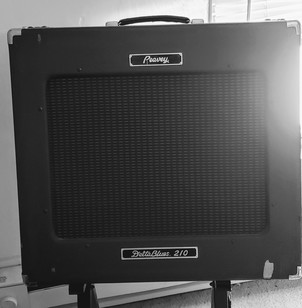When selecting your first guitar amp, there are a few things to take into consideration. First things first is the almighty dollar, you really need to think about your budget. Next up for consideration is the type of music you enjoy playing, and the tone you prefer. It may be best to begin with something small. You may believe that if you have a fat stack of cash a Marshall stack is the way to go, but big amps are difficult to work with at home because you have to really crank them up to drive them into that distortion point we all know and love. So your first amp should be smaller regardless of how full your wallet is. Lets try to keep John Law from pounding on your door, Neighbors somewhat happy and anyone else in the house off your back. Keep in mind also that a big amp takes up some square footage and unless you have a huge place it’s going to be in the way. I can tell you from experience that a quick trip to the bathroom in the middle of the night has ended up more than once in a screaming surprise by smashing a toe into a huge amp that I may have left in the wrong place.
For home practice or casual jam sessions, anything above 30 watts is usually big time overkill. If your playing arenas or something huge you can use a stack but most clubs are good with a smaller amp that you can drive at a much lower volume. Remember that even a 15-watt amp is audible when turned on. What you give up when you reduce the wattage is clean volume. However, if you primarily use a dirty, overdriven tone, small will suffice. I’m currently using a Peavey Delta Blues 210 which is 30 watts. I’m usually asked to turn down so it can get pretty loud on its own. I love this amp, it has tone for days. I’ve been offered way more than I paid for it but I refuse to sell it. She’s been around so there’s a ding or 2 on her but I won’t sell. You can still get these but I have never seen another one in black only tweed.
While amplifiers come in a variety of configurations, We will focus on three types: tube, modeling, and solid-state mini amps. Tube amplifiers, which are typically the most expensive type, are highly regarded for their tonal qualities and heritage dating back to the early days of amplified music. I love my tube amps but if your inexperienced keep in mind that tube amps are extremely heavy and difficult to move around. If you drop them or bump them in the wrong way it can be expensive to fix. They require a lot of maintenance so you will need to learn or find someone to help you with that.
Modeling amplifiers are less expensive, require less maintenance, and offer a wide range of tonal options (many very similar to tube amplifiers). Finally, portable mini amps are an excellent choice for anyone looking for a small, battery-powered practice amp that can be carried in a backpack. One thing to remember is that, watt for watt, tube amplifiers are much louder than their solid-state and modeling counterparts.
Here are some recommendations for you:
Tube Amps
Fender Pro Junior IV
Personally, I love Fenders! So we’ll start with them first. The Fender Pro Junior IV is a tube-driven guitar combo with a 10″ Jensen P10R speaker that replicates the harmonically complex output and sensitivity to playing dynamics that fans of that vintage Fender tone adore. The same celebrated midrange as vintage combos is produced by two 12AX7 tubes in the preamp section and two EL84 power amp tubes. Long-revered by players of all stripes, the 15-watt Pro Junior IV adds a modified volume circuit and a classic tweed appearance to this workhorse amplifier. A compact and straightforward tone machine, this amp is ideal for performing guitarists who need great tone and remarkably touch-sensitive dynamic response.
Peavey Delta Blues 210
Peavey Delta Blues 210, I know quite a bit about this one because it’s been my main gigging amp for quite a number of years now. It has the cream of an AC30 at a working man’s price. I bought mine used in a guitar store and not once have I regretted this purchase. I would recommend any of the Delta Blues to anyone looking for their next amp! They are built like tanks and all have a glassy full sound that stands out in a crowd. I just love this thing! An American A-Class Amp falling somewhere between a fender reverb amp and a Vox AC-30 (which it is similar to in architecture). The reverb is not as deep as a fender (but it seems to fall right on perfect). The tone of this amp is incredible, and that is what tube amps are for, and it is well worth the price of admission. I have often said that “It has tone for days”. It weighs under 50 lbs (45 to be exact). Other manufacturers should really take note of this. The amp is by no means backbreaking for me to carry. Tube amps don’t need to come standard with a hernia. This beautiful amplifier is perfect for jamming or gigging. It has an effects loop, Sweet reverb, and 2 10 inch Celestion speakers. Can you tell I love her?
VOX AC4C1-12
Take a look at the VOX AC4C1-12 if you want a classic British tone. The 4-watt AC4 is powered by VOX’s classic Top Boost circuit, which was is the same as their iconic AC30 and is routed through a 12″ Celestion speaker. Gain, Bass, Treble, and Volume controls offer a wide range of tone shaping options. The AC4 is incredibly portable by tube amp standards, weighing just under 24 lbs. Famous for its ability to achieve classic VOX tone at low volume levels, the AC4 is one of the most popular amps in VOX’s lineup. An ideal choice for the home or the studio, the AC4 Custom serves up an array of authentic VOX tone through it’s internal speaker and can even be paired with external speaker cabinet for more tonal diversity. This iconic low-wattage amp was first introduced by VOX in 1961 and is still the choice of many modern guitarists who are drawn to its mesmerizing tone and classic aesthetic. I have a pal that owns the AC30 and if this sounds half as good your gonna be happy.
Modeling Amps
Line 6’s Spider amplifiers
Line 6’s Spider amplifiers, which were first released in 1999, have set the standard for inexpensive, high-quality modeling guitar amplifiers. The Spider V MKII, which was released in the summer of 2019, comes with over 200 different amps, cabs, and effects. The Line 6 Spider V MKII amps, which come in seven different configurations, are an excellent option for anyone looking for a powerful amp at a reasonable price. I would recommend the V20 or V30.
BOSS’ Katana amps
BOSS’ Katana amps were first released in 2016 as part of the development of their Waza line of guitar products. The new Katana MKII amps, which were revised in 2019, have five distinct amp “characteristics” as well as five separate effects parts (Booster, Mod, FX, Delay, and Reverb), each with three different variations. Using the BOSS Tone Studio Software or the settings on the amp itself you can create that perfect tone.
Mini Amps
Blackstar Fly
If you’re looking for a portable mini amp, the Blackstar Fly 3 is the amp for you. The Fly 3 has two channels, a digital delay built in, and Blackstar’s proprietary Infinite Shape Feature, which allows you to switch between U.K. and U.S.-style tone. The aux. line in is great for attaching your phone, and the headphone out and emulated line are great for quiet practice and recording (Also a bonus for your roommates and neighbors). You can ditch the aux cord now also with a Bluetooth Equipped Fly 3 that is now available.

Recent Comments